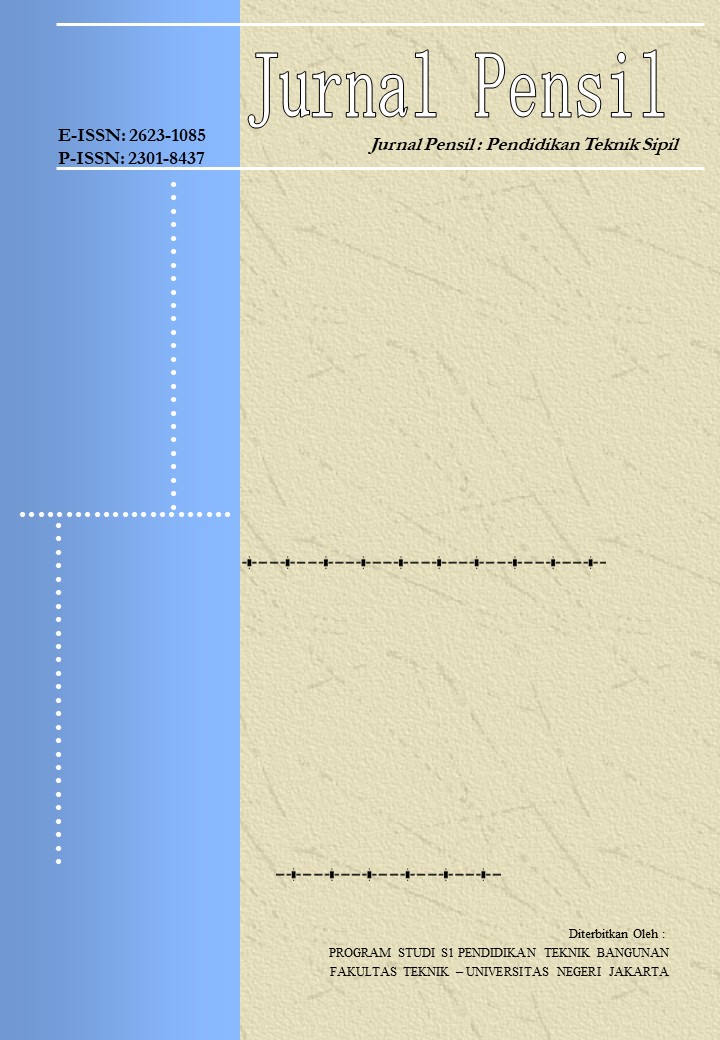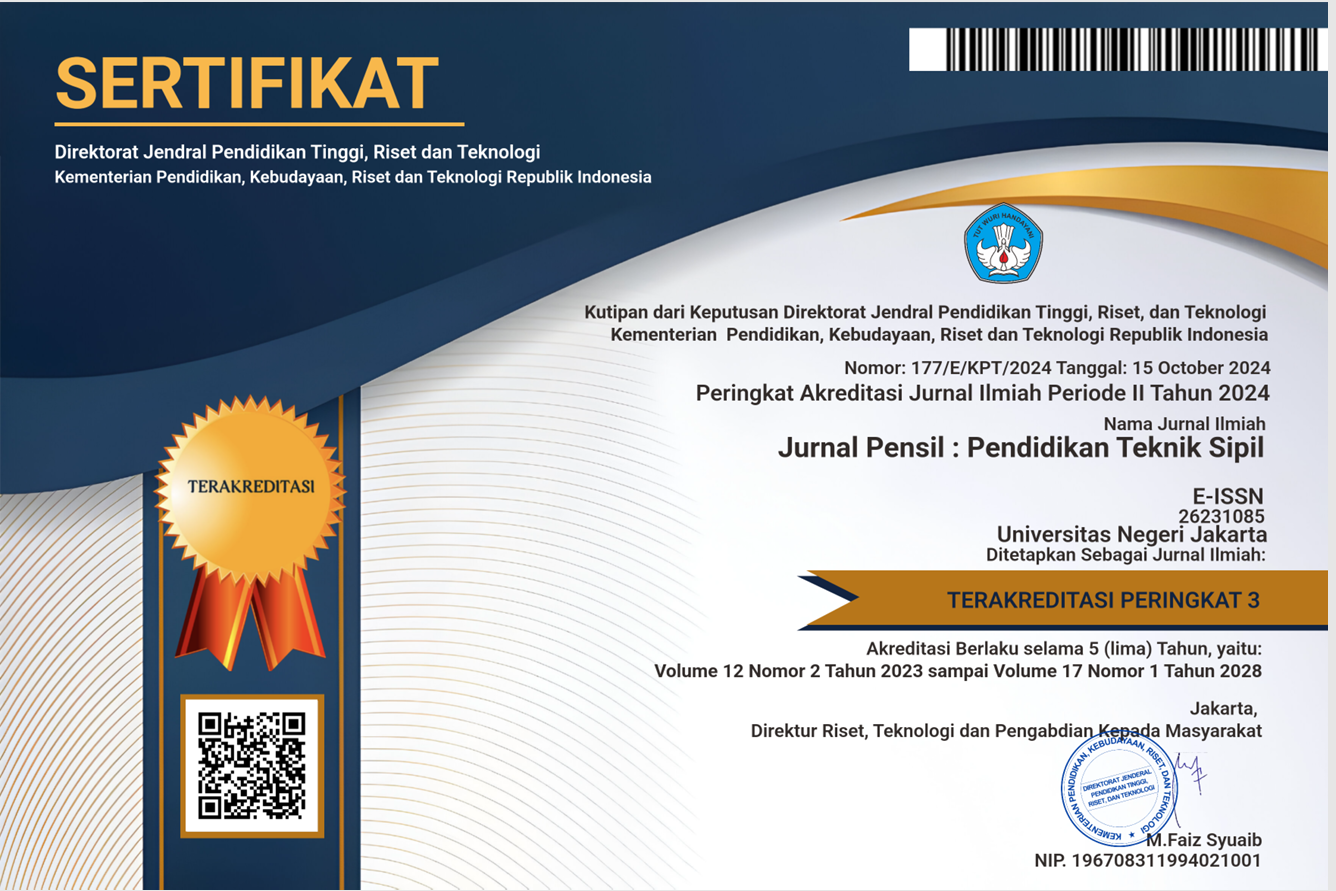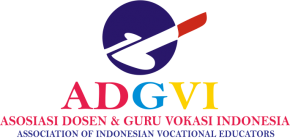MAPPING THE UTILIZATION OF AUGMENTED REALITY MEDIA IN VOCATIONAL EDUCATION IN DIY USING K-MEANS
DOI:
https://doi.org/10.21009/jpensil.v11i3.26776Keywords:
Learning Augmented Reality, VHS, K-MeansAbstract
The purpose of this study is to reveal group data on the use of augmented reality media in teaching and learning activities so that it is easier to improve student learning outcomes. Augmented reality media was chosen based on the complexity of the scope of teaching materials consisting of thinking skills and limited practice during the implementation of distance learning. The approach for grouping the use of augmented reality media is through the K-Means algorithm with R software. The sample of this study was 136 students of Building Information and Modeling Design skills competency from 5 State Vocational High Schools spread across districts and cities, DIY Province. The review aspect used as the basis for grouping is the need for alternative media in augmented reality, ease of use, supporting facilities, and speed of understanding the material. The grouping results explain that as many as 80 students can master the material well through augmented reality media, and it is appropriate to use it during distance learning. In comparison, the remaining 56 students still find it difficult. Through the results of this grouping, it can be used to combine other media for students who still find it difficult when participating in distance learning
References
Apriansyah, M. R. (2020). Pengembangan Media Pembelajaran Video Berbasis Animasi Mata Kuliah Ilmu Bahan Bangunan Di Program Studi Pendidikan Teknik Bangunan Fakultas Teknik Universitas Negeri Jakarta. Jurnal PenSil, 9(1), 9–18. https://doi.org/10.21009/jpensil.v9i1.12905
Ariska, D., Diponegoro, A., Tentama, F., Psikologi, M., Psikologi, F., & Dahlan, U. A. (2020). Validitas dan Reliabilitas Skala Efikasi Diri Pada Guru Smk Dengan Pemodelan Structural Equation Modelling (SEM). Jurnal Penelitian Dan Pengukuran Psikologi, 10, 125–130.
Arthur, R., Dwi, R. N., & Lenggogeni, L. (2020). E-Module of Cost Estimating Course in Building Construction Vocational Undergraduate Program Faculty of Engineering Universitas Negeri Jakarta. Jurnal Ilmu Pendidikan, 25(2), 88. https://doi.org/10.17977/um048v25i2p88-96
Beck, D. (2019). Augmented and Virtual Reality in Education: Immersive Learning Research. Journal of Educational Computing Research, 57(7), 1619–1625. https://doi.org/10.1177/0735633119854035
Cheer, J. M., Lapointe, D., Mostafanezhad, M., & Jamal, T. (2021). Global tourism in crisis: conceptual frameworks for research and practice. Journal of Tourism Futures, 7(3), 278–294. https://doi.org/10.1108/JTF-09-2021-227
De Pace, F., Manuri, F., & Sanna, A. (2018). Augmented Reality in Industry 4.0. American Journal of Computer Science and Information Technology, 06(01), 1–7. https://doi.org/10.21767/2349-3917.100017
Dewi, N., Murtinugraha, R. E., & Arthur, R. (2018). Pengembangan Media Pembelajaran Interaktif Pada Mata Kuliah Teori Dan Praktik Plambing Di Program Studi S1 Pvkb Unj. Jurnal PenSil, 7(2), 95–104. https://doi.org/10.21009/pensil.7.2.6
Elmqaddem, N. (2019). Augmented Reality and Virtual Reality in education. Myth or reality? International Journal of Emerging Technologies in Learning, 14(3), 234–242. https://doi.org/10.3991/ijet.v14i03.9289
Ermawan, T. D., & Subari. (2022). Perancangan Augmented Reality Bidang Otomotif Untuk Siswa SMK Jurusan Teknik Sepeda Motor. Teknika, 11(2), 129–137. https://doi.org/10.34148/teknika.v11i2.479
Fang, H., Wen, J., Yang, X., Wang, P., & Li, Y. (2022). Assisted Human-Robot Interaction for Industry Application Based Augmented Reality. Springer Nature Switzerland AG, 13318.
Gaol, F. L., & Prasolova-Førland, E. (2022). Special section editorial: The frontiers of augmented and mixed reality in all levels of education. Education and Information Technologies, 27(1), 611–623. https://doi.org/10.1007/s10639-021-10746-2
Hamzah, M. L., Ambiyar, Rizal, F., Simatupang, W., Irfan, D., & Refdinal. (2021). Development of Augmented Reality Application for Learning Computer Network Device. International Journal of Interactive Mobile Technologies, 15(12), 47–64. https://doi.org/10.3991/ijim.v15i12.21993
Hermawan, H., Saputra, D. I. S., & Hariawan, A. (2022). Markerless Augmented Reality Motorcycle Engine Using Database for Interactive Online Learning Media. International Journal of Mechanical Engineering, 7(1), 515–523.
Kim, J. C., Laine, T. H., & Åhlund, C. (2021). Multimodal interaction systems based on internet of things and augmented reality: A systematic literature review. Applied Sciences (Switzerland), 11(4), 1–33. https://doi.org/10.3390/app11041738
Köhler, T., Wollersheim, H.-W., & Igel, C. (2019). Scenarios of Technology Enhanced Learning (TEL) and Technology Enhanced Teaching (TET) in Academic Education A Forecast for the Next Decade and its Consequences for Teaching Staff. IEEE Xplore.
Kounlaxay, K., Shim, Y., Kang, S. J., Kwak, H. Y., & Kim, S. K. (2021). Learning media on mathematical education based on augmented reality. KSII Transactions on Internet and Information Systems, 15(3), 1015–1029. https://doi.org/10.3837/tiis.2021.03.011
Kuleto, V., Ilić, M. P., Šević, N. P., Ranković, M., Stojaković, D., & Dobrilović, M. (2021). Factors affecting the efficiency of teaching process in higher education in the republic of serbia during covid-19. Sustainability (Switzerland), 13(23), 1–20. https://doi.org/10.3390/su132312935
Lai, J. W., & Cheong, K. H. (2022). Adoption of Virtual and Augmented Reality for Mathematics Education: A Scoping Review. IEEE Access, 10, 13693–13703. https://doi.org/10.1109/ACCESS.2022.3145991
Mahrous, A., Elgreatly, A., Qian, F., & Schneider, G. B. (2021). a Comparison of Pre-Clinical Instructional Technologies: Natural teeth, 3D models, 3D Printing, and Augmented Reality. Journal of Dental Education, 85(11), 1795–1801. https://doi.org/10.1002/jdd.12736
Majid, A. F., Ichiana, N. N., Yuliany, N., Angriani, A. D., Hafsyah, & Kusumayanti, A. (2021). Calcu card: Developing augmented reality-based learning media on the three-dimensional shapes with curves lesson for junior high school student. Journal of Physics: Conference Series, 1918(4). https://doi.org/10.1088/1742-6596/1918/4/042124
Mardasari, O. R., Susilowati, N. E., Luciandika, A., Nagari, P. M., & Yanhua, Z. (2022). Applying Augmented Reality in Foreign Language Learning Materials: Research and Development. Proceedings of the International Seminar on Language, Education, and Culture (ISoLEC 2021), 612(ISoLEC), 253–258. https://doi.org/10.2991/assehr.k.211212.047
Martins, N. C., Marques, B., Alves, J., Araújo, T., Dias, P., & Santos, B. S. (2022). Augmented reality situated visualization in decision-making. Multimedia Tools and Applications, 81(11), 14749–14772. https://doi.org/10.1007/s11042-021-10971-4
Munastiwi, E. (2021). Adaptation of Teaching-Learning Models Due to Covid-19 Pandemic: Challenge Towards Teachers Problem-Solving Skills. Jurnal Ilmiah Sekolah Dasar, 5(1), 33. https://doi.org/10.23887/jisd.v5i1.32695
Murod, U., Suvankulov, B., … M. B.-A. of the, & 2021, undefined. (2021). Fundamentals of Creation and Use of Interactive Electronic Courses on the Basis of Multimedia Technologies. Annalsofrscb.Ro, 25(4), 6860–6865. https://www.annalsofrscb.ro/index.php/journal/article/view/3282%0Ahttp://annalsofrscb.ro/index.php/journal/article/view/3282
Nadeem, M., Lal, M., Cen, J., & Sharsheer, M. (2022). AR4FSM: Mobile Augmented Reality Application in Engineering Education for Finite-State Machine Understanding. Education Sciences, 12(8), 555. https://doi.org/10.3390/educsci12080555
Panagiotidis, P. (2021). Virtual Reality Applications and Language Learning. International Journal for Cross-Disciplinary Subjects in Education, 12(1), 4447–4454. https://doi.org/10.20533/ijcdse.2042.6364.2021.0543
Pratama, G. N. I. P., Triyono, M. B., Hasanah, N., Kenzhaliyev, O. B., Kosherbayeva, A. N., Kassymova, G. K., & Azman, M. N. A. (2022). Development of Construction Engineering Teaching Course by Using VR-AR: A Case Study of Polytechnic in Indonesia. International Journal of Interactive Mobile Technologies, 16(14), 93–106. https://doi.org/10.3991/ijim.v16i14.30539
Puspitasari, H., Suryadarma, I. G. P., & Pujianto. (2021). Pandemic Era, Education Support Technology: The Potential for Augmented Reality in Science Learning. Proceedings of the 6th International Seminar on Science Education (ISSE 2020), 541(Isse 2020), 727–737. https://doi.org/10.2991/assehr.k.210326.105
Putra, A. K., Sumarmi, A. S., Fajrilia, A., Islam, M. N., & Yembuu, B. (2021). Effect of Mobile-Augmented Reality (MAR) in Digital Encyclopedia on The Complex Problem Solving and Attitudes of Undergraduate Student. International Journal of Emerging Technologies in Learning, 16(7), 119–134. https://doi.org/10.3991/ijet.v16i07.21223
Riani, A., Utomo, E., & Nuraini, S. (2021). Development of Local Wisdom Augmented Reality (AR) Media in Elementary Schools. International Journal of Multicultural and …, 154–162. http://ijmmu.com/index.php/ijmmu/article/view/2735
Sitohang, G. J., Sumiati, A., & Susanti, S. (2021). Effect of Problem Based Instruction Model Based on Learning Video and Educational Games Media on the Self Efficacy of Students of Class X SMK N 17 Jakarta. Journal Corner of Education, Linguistics, and Literature, 1(2), 106–113. https://doi.org/10.54012/jcell.v1i2.9
Sumarna, K. (2019). Pengaplikasian Augmented Reality Pada Modul Pembelajaran Menggambar Teknik 2 dan CAD di Program Studi Pendidikan Teknik Bangunan, Fakultas Teknik, Universitas Negeri Jakarta. Jurnal PenSil, 8(2), 89–96. https://doi.org/10.21009/jpensil.v8i2.11956
Suratno, A., & Nugroho, E. W. (2021). Augmented Reality-Based Learning Media Design: Its Compatibility to Blended Learning. Proceedings of the Eighth International Conference on English Language and Teaching (ICOELT-8 2020), 579, 41–48. https://doi.org/10.2991/assehr.k.210914.008
Susanto, E., & Mulyaningsih, F. (2020). Distance Learning : Does It Have An Impact On The Readiness Of Physical Education Teachers In Coastal Areas ? Physical Education Theory and Methodology, 7989, 338–345. https://doi.org/10.17309/tmfv.2022.3.06
Sutiman, S., Sofyan, H., Arifin, Z., Nurtanto, M., & Mutohhari, F. (2022). Industry and Education Practitioners’ Perceptions Regarding the Implementation of Work-Based Learning through Industrial Internship (WBL-II). International Journal of Information and Education Technology, 12(10), 1090–1097. https://doi.org/10.18178/ijiet.2022.12.10.1725
Syahidi, A. A., Banjarmasin, P. N., Arai, K., Tolle, H., & Supianto, A. (2021). Augmented Reality in the Internet of Things ( AR + IoT ): A Review Augmented Reality in the Internet of Things ( AR + IoT ): A Review. International Journal of Informatics and Computer Science, 5(December), 258–265. https://doi.org/10.30865/ijics.v5i3.3341
Triyono, B. M., Mohib, N., Kassymova, G. K., Pratama, G. N. I. P., Adinda, D., & Arpentieva, M. R. (2020). The Profile Improvement of Vocational School Teacher’s Competencies. Vysshee Obrazovanie v Rossii, 29(2), 151–158. https://doi.org/10.31992/0869-3617-2020-29-2-151-158
Wibowo, G. V., Putro, K. Z., & Khotimah, I. A. (2022). Pembelajaran Online Pada Mata Kuliah Sosial-Emosional Aud Bagi Mahasiswa Selama Pandemi Covid-19. Research and Development Journal of Education, 8(1), 25. https://doi.org/10.30998/rdje.v8i1.10086
Wulandari, I., Irwansyah, F. S., Farida, I., & Ramdhani, M. A. (2019). Development of student’s submicroscopic representation ability on molecular geometry material using Augmented Reality (AR) media. Journal of Physics: Conference Series, 1280(3). https://doi.org/10.1088/1742-6596/1280/3/032016











.png)
.png)
1.png)

